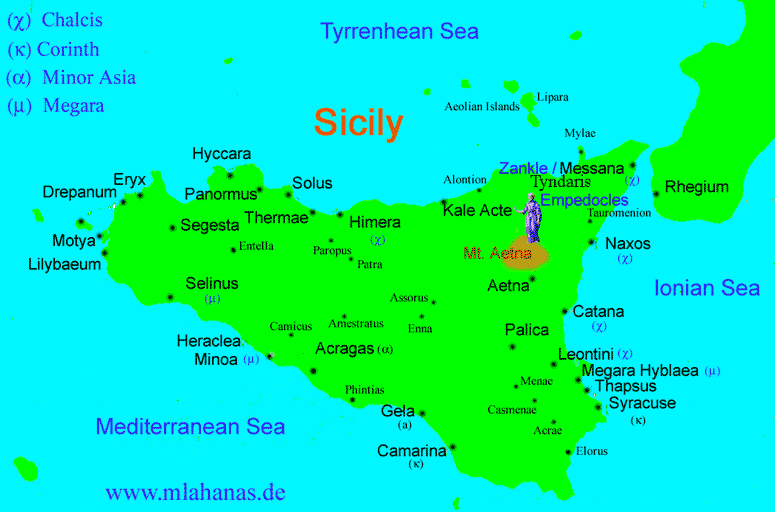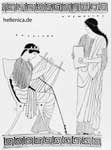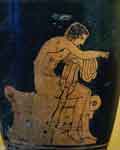.
Γέλα, πόλις Σικελίας. ἡ γενικὴ Γέλας. τὸ δὲ Γέλης ἰωνικόν. καλεῖται δὲ ἀπὸ ποταμοῦ Γέλα, ὁ δὲ ποταμὸς ὅτι πολλὴν πάχνην γεννᾷ· ταύτην γὰρ τῇ Ὀπικῶν φωνῇ καὶ Σικελῶν γέλαν λέγεσθαι. Πρόξενος δ´ ἐν πρώτῃ τῶν περὶ πόρων Σικελικῶν καὶ Ἑλλάνικος ἀπὸ Γέλωνος τοῦ Αἴτνης καὶ Ὑμάρου. Ἀρισταίνετος δ´ ἐν πρώτῃ τῶν περὶ Φασήλιδα, ὅτι Λάκιος καὶ Ἀντίφημος ἀδελφοὶ ἐλθόντες εἰς Δελφοὺς μαντεύσασθαι, τὴν δὲ Πυθίαν οὐδὲν περὶ ἐκείνων λέγουσαν προστάσσειν τὸν Λάκιον πρὸς ἀνατολὰς ἡλίου πλεῖν. τοῦ δ´ Ἀντιφήμου γελάσαντος τὴν Πυθίαν εἰπεῖν πάλιν ἐφ´ ἡλίου δυσμῶν, καὶ Γέλαν πόλιν οἰκίσαι. τὸ ἐθνικὸν Γελῶος, οὐ Γελαῖος, ὡς Ἅβρων καὶ ἡ συνήθεια. καὶ ἴσως ἀπὸ τοῦ γέλως τὸ Γελῶος. Stephanus of Byzantium

Gela (Italian pronunciation: [ˈdʒɛːla]; Ancient Greek: Γέλα[3]), is a city and comune in the Autonomous Region of Sicily, Italy; in terms of area and population, it is the largest comune on Sicily's southern coast. Gela is part of Caltanissetta province and is the only comune in Italy with a population and area that exceed those of the province's capital.[4]
Gela was founded in 698 BC by Greek colonists from Rhodes and Crete; it was an influential polis in Sicily in the 7th and 6th centuries BC and the place where Aeschylus (died 456 BC) lived and died.[5] In 1943, during the Invasion of Sicily, the Allied forces made their first landing on the island at Gela.[6]

Timoleon Walls Gela, Italian Stamp
History
Ancient era
Gela was founded around 688 BC by colonists from Rhodes and Crete, 45 years after the founding of Syracuse. The city was named after the river Gela, the name of which derives from gela, the Sicilian-dialect word for "winter frost".[7] According to Diodorus Siculus, the city was founded by the Antiphemus (Ἀντίφημος) and the Entimus (Ἔντιμος).[8]
The Greeks established many colonies in Magna Graecia, and for many centuries, they had a major influence on the area. Gela flourished and after a century, a group of Geloi founded the colony of Agrigento.[9] The expansion led to economic and social strain, causing people to leave the city and settle in nearby Maktorion.[10]
For over a century, ancient historians made no further mention was made about the internal politics of the cityuntil they note that a tyrant named Cleander ruled Gela between 505 BC and 498 or 497 BC.[11] After his death, power transferred to his brother Hippocrates, who conquered Callipoli, Leontini, Naxos, Hergetios and Zancles (present-day Messina).[12] Only Syracuse, with the help of her former colonizing city Corinth and Corcyra managed to escape. When Camarina, a Syracusan colony, rebelled in 492 BC, Hippocrates intervened to wage war against Syracuse. After defeating the Syracusan army at the Heloros river, Hippocrates besieged the city but was persuaded to retreat in exchange for possession of Camarina. Hippocrates died in 491 BC in a battle against the Siculi, the native Sicilian people.[13]
A Sileno head from Gela Archeological Museum
Hippocrates was succeeded by Gelon, who in 484 BC conquered Syracuse and moved his seat of government there. His brother Hiero was given control over Gela.[7] When Theron of Agrigento conquered Himera and a Carthaginian army disembarked in Sicily to counter him, he asked for help from Gela and Syracuse. Gelo and Hiero were victorious in the subsequent battle of Himera, in which the Carthaginian leader Hamilcar died.[14]
After the death of Gelon in 478 BC, Hiero moved to Syracuse, leaving Gela to Polyzelos. Thenceforth, the history of the city becomes uncertain: it has been suggested[by whom?] the citizens freed themselves from the rule of tyrants and established a democratic government. Many of the Geloi returned from Syracuse in this period and the city regained some of its power. Aischylos died in this city in 456 BC. Gela fought the Sicilian League that pushed back the Athenian attempt to conquer the island in 415 BC (see Sicilian Expedition).
In 406 BC, the Carthaginians conquered Agrigento and destroyed it. Gela asked for the help of Dionysius I of Syracuse but for unknown reasons, Dionysius did not arrive in time and, after heroic deeds, the following year, Gela was ruined in and its treasures were sacked. The survivors took refuge in Syracuse.[15][16] In 397 BC, they returned in Gela and joined Dionysius II in his struggle for freedom from the invaders, and in 383 BC, their independence was acknowledged.
Under Agathocles (317-289 BC), the city again suffered internal strife between the general population and the aristoi (aristocrats). When the Carthaginians arrived in 311 BC, they met little resistance and captured the city with the help of the aristoi. In 282 BC, of Agrigento, who had founded a city next to present-day Licata, ruthlessly destroyed Gela to crush its power forever.[17] This assertion, however, seems to be refuted by a careful reading of the sources that name the Mamertines as the real destroyers of the city, five years earlier.[18]
Sights in and around Gela

Akropolis, Gela, Molino a Vento.

Weight from Gela
Akropolis
Archeological museum
Archeological site Capo Soprano
Greek temples
Persons

Polyzalos, one of the sons of Deinomenos the tyrant of Gela in Sicily who dedicated The Charioteer of Delphi to Apollo after winning a Pythian Games chariot race (478/0) BC.

Rivergod Gelas



Herakles beardless MAR Palermo NI2153, Group of Palermo 16
A - B - C - D - E - F - G - H - I - J - K - L - M-
N - O - P - Q - R - S - T - U - V - W - X - Y - Z
Α - Β - Γ - Δ - Ε - Ζ - Η - Θ - Ι - Κ - Λ - Μ -
Ν - Ξ - Ο - Π - Ρ - Σ - Τ - Υ - Φ - Χ - Ψ - Ω
| Ancient Greece
Science, Technology , Medicine , Warfare, , Biographies , Life , Cities/Places/Maps , Arts , Literature , Philosophy ,Olympics, Mythology , History , Images Medieval Greece / Byzantine Empire Science, Technology, Arts, , Warfare , Literature, Biographies, Icons, History Modern Greece Cities, Islands, Regions, Fauna/Flora ,Biographies , History , Warfare, Science/Technology, Literature, Music , Arts , Film/Actors , Sport , Fashion --- |
Retrieved from "http://en.wikipedia.org/"
All text is available under the terms of the GNU Free Documentation License


